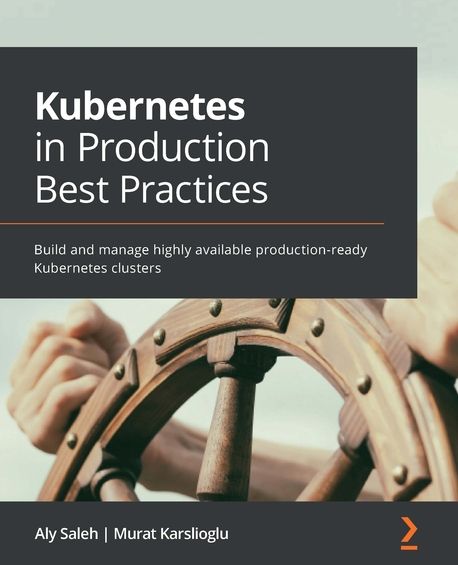Kubernetes in Production Best Practices
2021년 03월 12일 출간
- eBook 상품 정보
- 파일 정보 PDF (3.51MB)
- ISBN 9781800202719
- 지원기기 교보eBook App, PC e서재, 리더기, 웹뷰어
-
교보eBook App
듣기(TTS) 가능
TTS 란?텍스트를 음성으로 읽어주는 기술입니다.
- 전자책의 편집 상태에 따라 본문의 흐름과 다르게 텍스트를 읽을 수 있습니다.
- 이미지 형태로 제작된 전자책 (예 : ZIP 파일)은 TTS 기능을 지원하지 않습니다.
PDF 필기가능 (Android, iOS)

쿠폰적용가 17,100원
10% 할인 | 5%P 적립이 상품은 배송되지 않는 디지털 상품이며,
교보eBook앱이나 웹뷰어에서 바로 이용가능합니다.
카드&결제 혜택
- 5만원 이상 구매 시 추가 2,000P
- 3만원 이상 구매 시, 등급별 2~4% 추가 최대 416P
- 리뷰 작성 시, e교환권 추가 최대 200원
작품소개
이 상품이 속한 분야
▶Book Description
Although out-of-the-box solutions can help you to get a cluster up and running quickly, running a Kubernetes cluster that is optimized for production workloads is a challenge, especially for users with basic or intermediate knowledge. With detailed coverage of cloud industry standards and best practices for achieving scalability, availability, operational excellence, and cost optimization, this Kubernetes book is a blueprint for managing applications and services in production.
You'll discover the most common way to deploy and operate Kubernetes clusters, which is to use a public cloud-managed service from AWS, Azure, or Google Cloud Platform (GCP). This book explores Amazon Elastic Kubernetes Service (Amazon EKS), the AWS-managed version of Kubernetes, for working through practical exercises. As you get to grips with implementation details specific to AWS and EKS, you'll understand the design concepts, implementation best practices, and configuration applicable to other cloud-managed services. Throughout the book, you'll also discover standard and cloud-agnostic tools, such as Terraform and Ansible, for provisioning and configuring infrastructure.
By the end of this book, you'll be able to leverage Kubernetes to operate and manage your production environments confidently.
▶What You Will Learn
-Explore different infrastructure architectures for Kubernetes deployment
-Implement optimal open source and commercial storage management solutions
-Apply best practices for provisioning and configuring Kubernetes clusters, including infrastructure as code (IaC) and configuration as code (CAC)
-Configure the cluster networking plugin and core networking components to get the best out of them
-Secure your Kubernetes environment using the latest tools and best practices
-Deploy core observability stacks, such as monitoring and logging, to fine-tune your infrastructure
-Chapter 1: Introduction to Kubernetes Infrastructure and Production-Readiness
-Chapter 2: Architecting Production-Grade Kubernetes Infrastructure
-Chapter 3: Provisioning Kubernetes Clusters Using AWS and Terraform
-Chapter 4: Managing Cluster Configuration with Ansible
-Chapter 5: Configuring and Enhancing Kubernetes Networking Services
-Chapter 6: Securing Kubernetes Effectively
-Chapter 7: Managing Storage and Stateful Applications
-Chapter 8: Deploying Seamless and Reliable Applications
-Chapter 9: Monitoring, Logging, and Observability
-Chapter 10: Operating and Maintaining Efficient Kubernetes Clusters
▶What this book covers
- Chapter 1, Introduction to Kubernetes Infrastructure and Production-Readiness, teaches you about the basics of Kubernetes infrastructure, then explains the principles of infrastructure designing, and finally the characteristics of production-ready clusters.
- Chapter 2, Architecting Production-Grade Kubernetes Infrastructure, teaches you about the various aspects, trade-offs, and best practices that you need to consider while designing Kubernetes infrastructure.
- Chapter 3, Provisioning Kubernetes Clusters Using AWS and Terraform, teaches you how to use AWS, Terraform, and infrastructure as code techniques to provision Kubernetes infrastructure.
- Chapter 4, Managing Cluster Configurations with Ansible, teaches you how to use Ansible to build a flexible and scalable configuration management solution for Kubernetes clusters.
- Chapter 5, Configuring and Enhancing Kubernetes Networking Services, teaches you how to configure and improve Kubernetes cluster networking, and the essential Kubernetes networking add-ons to use.
- Chapter 6, Securing Kubernetes Effectively, teaches you about Kubernetes security best practices, and how to validate and ensure the security of clusters.
- Chapter 7, Managing Storage and Stateful Applications, teaches you how to overcome storage challenges in Kubernetes using the best storage management solution in the ecosystem.
- Chapter 8, Deploying Seamless and Reliable Applications, teaches you container and image best practices, as well as application deployment strategies to achieve scalable service in production.
- Chapter 9, Monitoring, Logging, and Observability, teaches you Kubernetes observability best practices, important metrics to watch for, as well as the monitoring and logging stacks available in the market, and when to use each of them.
- Chapter 10, Operating and Maintaining Efficient Kubernetes Clusters, teaches you Kubernetes operation best practices, as well as cluster maintenance tasks such
▶ Preface
Kubernetes is an open source container orchestration platform originally developed by Google and made available to the public in 2014. The popularity of Kubernetes helped to make the deployment of container-based, complex, distributed systems simpler to manage for developers. Since its inception, the community has built a large ecosystem around Kubernetes, with many open source projects that have made the automation of management functions possible.
This book is specifically designed to quickly help Kubernetes administrators and site reliability engineers (SREs) to build and manage production-grade Kubernetes infrastructure following industry best practices and well-proven techniques learned from early technology adopters of large-scale Kubernetes deployments.
While we use Amazon Elastic Kubernetes Service (EKS) to deliver the practical exercises in this book, we believe that the explained Kubernetes design, provisioning, and configuration concepts and techniques remain valid for other cloud providers. Regarding the selection of provisioning and configuration tools, we decided to use cloud-agnostic tools such as Terraform and Ansible to ensure portability across cloud providers.
Kubernetes in Production Best Practices gives you the confidence to use Kubernetes to host your production workloads, having the comprehensive infrastructure design knowledge to build your clusters and a clear understanding of managing and operating them efficiently.
작가정보
저자(글) Aly Saleh
Aly Saleh is a technology entrepreneur, cloud transformation leader, and architect. He has worked for the past 2 decades on building large-scale software solutions and cloud-based platforms and services that are used by millions of users. He is a co-founder of MAVS Cloud, a start-up that empowers organizations to leverage the power of the cloud. He also played various technical roles at Oracle, Vodafone, FreshBooks, Aurea Software, and Ceros.Aly holds degrees in computer science, and he has gained multiple credentials in AWS, GCP, and Kubernetes, with a focus on building cloud platforms, app modernization, containerization, and architecting distributed systems. He is an advocate for cloud best practices, remote work, and globally distributed teams.
저자(글) Murat Karslioglu
Murat Karslioglu is a distinguished technologist with years of experience using infrastructure tools and technologies. Murat is currently the VP of products at MayaData, a start-up that builds data agility platform for stateful applications, and a maintainer of open source projects, namely OpenEBS and Litmus. In his free time, Murat is busy writing practical articles about DevOps best practices, CI/CD, Kubernetes, and running stateful applications on popular Kubernetes platforms on his blog, Containerized Me. Murat also runs a cloud-native news curator site, The Containerized Today, where he regularly publishes updates on the Kubernetes ecosystem.
이 상품의 총서
Klover리뷰 (0)
- - e교환권은 적립일로부터 180일 동안 사용 가능합니다.
- - 리워드는 5,000원 이상 eBook, 오디오북, 동영상에 한해 다운로드 완료 후 리뷰 작성 시 익일 제공됩니다. (2024년 9월 30일부터 적용)
- - 리워드는 한 상품에 최초 1회만 제공됩니다.
- - sam 이용권 구매 상품 / 선물받은 eBook은 리워드 대상에서 제외됩니다.
- 도서나 타인에 대해 근거 없이 비방을 하거나 타인의 명예를 훼손할 수 있는 리뷰
- 도서와 무관한 내용의 리뷰
- 인신공격이나 욕설, 비속어, 혐오 발언이 개재된 리뷰
- 의성어나 의태어 등 내용의 의미가 없는 리뷰
구매 후 리뷰 작성 시, e교환권 100원 적립
문장수집
- 구매 후 90일 이내에 문장 수집 등록 시 e교환권 100원을 적립해 드립니다.
- e교환권은 적립일로부터 180일 동안 사용 가능합니다.
- 리워드는 5,000원 이상 eBook에 한해 다운로드 완료 후 문장수집 등록 시 제공됩니다. (2024년 9월 30일부터 적용)
- 리워드는 한 상품에 최초 1회만 제공됩니다.
- sam 이용권 구매 상품 / 선물받은 eBook / 오디오북·동영상 상품/주문취소/환불 시 리워드 대상에서 제외됩니다.
구매 후 문장수집 작성 시, e교환권 100원 적립
신규가입 혜택 지급이 완료 되었습니다.
바로 사용 가능한 교보e캐시 1,000원 (유효기간 7일)
지금 바로 교보eBook의 다양한 콘텐츠를 이용해 보세요!

- 구매 후 90일 이내 작성 시, e교환권 100원 (최초1회)
- 리워드 제외 상품 : 마이 > 라이브러리 > Klover리뷰 > 리워드 안내 참고
- 콘텐츠 다운로드 또는 바로보기 완료 후 리뷰 작성 시 익일 제공
가장 와 닿는 하나의 키워드를 선택해주세요.
총 5MB 이하로 jpg,jpeg,png 파일만 업로드 가능합니다.
신고 사유를 선택해주세요.
신고 내용은 이용약관 및 정책에 의해 처리됩니다.
허위 신고일 경우, 신고자의 서비스 활동이 제한될 수
있으니 유의하시어 신중하게 신고해주세요.
이 글을 작성한 작성자의 모든 글은 블라인드 처리 됩니다.
구매 후 90일 이내 작성 시, e교환권 100원 적립
eBook 문장수집은 웹에서 직접 타이핑 가능하나, 모바일 앱에서 도서를 열람하여 문장을 드래그하시면 직접 타이핑 하실 필요 없이 보다 편하게 남길 수 있습니다.
차감하실 sam이용권을 선택하세요.
차감하실 sam이용권을 선택하세요.
선물하실 sam이용권을 선택하세요.
-
보유 권수 / 선물할 권수0권 / 1권
-
받는사람 이름받는사람 휴대전화
- 구매한 이용권의 대한 잔여권수를 선물할 수 있습니다.
- 열람권은 1인당 1권씩 선물 가능합니다.
- 선물한 열람권이 ‘미등록’ 상태일 경우에만 ‘열람권 선물내역’화면에서 선물취소 가능합니다.
- 선물한 열람권의 등록유효기간은 14일 입니다.
(상대방이 기한내에 등록하지 않을 경우 소멸됩니다.) - 무제한 이용권일 경우 열람권 선물이 불가합니다.
첫 구매 시 교보e캐시 지급해 드립니다.

- 첫 구매 후 3일 이내 다운로드 시 익일 자동 지급
- 한 ID당 최초 1회 지급 / sam 이용권 제외
- 구글바이액션을 통해 교보eBook 구매 이력이 없는 회원 대상
- 교보e캐시 1,000원 지급 (유효기간 지급일로부터 7일)





